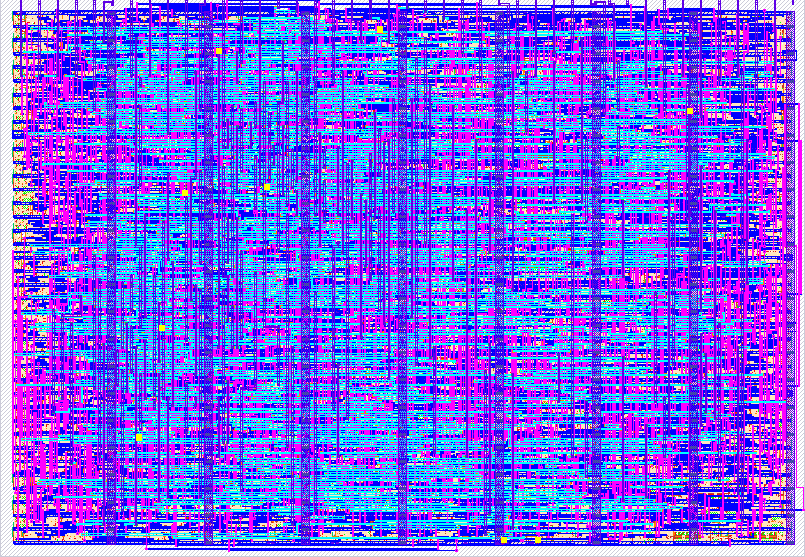620 Latch RAM (64 bytes)
620 : Latch RAM (64 bytes)

- Author: Mike Bell
- Description: 64 byte RAM built out of latches
- GitHub repository
- Open in 3D viewer
- Clock: 0 Hz
- Feedback: ✅ 1
What's the project?
A 64 byte RAM implemented using 512 latches.
Resetting the project does not reset the RAM contents.
How to test
To read a byte from memory:
- Set the
addrpins to the desired address and setwr_enlow - Pulse
clk data_out(the output pins) reads the value at the memory location.
To write a byte to memory:
- Set the
addrpins to the desired address, setdata_in(the bidirectional pins) to the desired value, and setwr_enhigh - Pulse
clk - The memory location will be written on the next cycle. The
data_outpins will now read the old value at this address. - The next cycle can not be a write.
On the cycle immediately after a write the value of wr_en and data_in will be ignored - the cycle is always a read. If addr is left the same then the value read will be the value just written to that location.
How it works
Setting values into latches reliably is a little tricky. There are two important considerations:
- The latch gate must only go high for the latches for the byte that is addressed. The other latch gates must not glitch.
- The data must be stable until the latch gate is definitely low again.
To ensure the restrictions are met, writes take 2 cycles, and only 1 write can be in flight at once, so the cycle after any write is always treated as a read.
The scheme used is described in detail below.
Writing: Ensuring stable inputs to the latches.
The write address, addr_write, is always set to the same value for 2 clocks when doing a write.
When the write is requested addr_write and data_to_write are captured. wr_en_next is set high.
If wr_en_next was already high the write is ignored, so the inputs to the latches aren't
modified when a write is about to happen.
On the next clock, wr_en_valid is set to wr_en_next. addr_write is stable at this time so the
sel_byte wires, that contain the result of the comparison of the write address with the byte address for each latch, will already be stable at the point wr_en_valid goes high.
wr_en_ok is a negative edge triggered flop that is set to !wr_en_valid. This will therefore
go low half a clock after wr_en_valid is set high. And because two consecutive writes are not
allowed it will always be high when wr_en_valid goes high.
The latch gate is set by anding together wr_en_valid, wr_en_ok and the sel_byte for that byte.
This means the latch gate for just the selected byte's latches goes high for the first half of
the write clock cycle. data_to_write is stable across this time (it can not change until the
next clock rising edge), so will be cleanly captured by the latch when the latch gate goes low.
Reading: Mux and tri-state buffer.
Reading the latches is straightforward. However, a 64:1 mux for each bit is relatively area intensive, so instead for each bit we have 4 16:1 muxes feeding 4 tri-state buffers.
Only the tri-state buffer corresponding to the selected read address is enabled, and the output is taken from the wire driven by those 4 buffers.
To minimize contention, the tri-state enable pin of the buffers is driven directly from a flop which
captures the selected read address directly from the inputs, at the same cycle as the addr_read flops are set.
The combined output wire then goes to a final buffer before leaving the module, ensuring the outputs are driven cleanly.
IO
| # | Input | Output | Bidirectional |
|---|---|---|---|
| 0 | addr[0] | data_out[0] | data_in[0] |
| 1 | addr[1] | data_out[1] | data_in[1] |
| 2 | addr[2] | data_out[2] | data_in[2] |
| 3 | addr[3] | data_out[3] | data_in[3] |
| 4 | addr[4] | data_out[4] | data_in[4] |
| 5 | addr[5] | data_out[5] | data_in[5] |
| 6 | data_out[6] | data_in[6] | |
| 7 | wr_en | data_out[7] | data_in[7] |
User feedback
- MichaelBell👑: Being careful to work around the possible contention on the internal tristate bus by clocking the project fast while it is enabled, I was able to run a tweaked version of the tests to confirm the 64 byte RAM works as expected! Test script: https://github.com/MichaelBell/tt-micropython-scripts/blob/main/latchmem_tb.py Link for more details